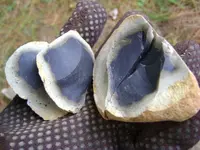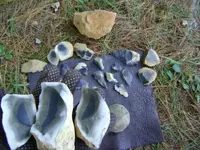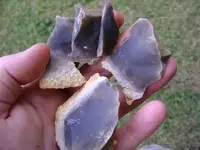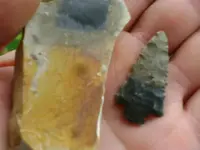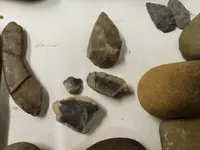You are using an out of date browser. It may not display this or other websites correctly.
You should upgrade or use an alternative browser.
You should upgrade or use an alternative browser.
Found some high grade chert in WV
- Thread starter Th3rty7
- Start date
TripleCreek
Jr. Member
- Joined
- Jan 27, 2009
- Messages
- 71
- Reaction score
- 2
- Golden Thread
- 0
- Location
- Mid Maryland
- Detector(s) used
- Tesoro- DeLeon
Hi 37,
I haven't been on for a while, busy summer, but trying to catch up. That looks like some nice material. It kind of looks like a "kentucky horn stone", which is a very hard rock. I have been experimenting with heat treating some rock at my place, buried under a camp fire. Have you tried heat treating it ? How large are the cobules that you are finding? Unfortunately Maryland has a dearth of good rock, but maybe I can think of something else I can trade you, for some to experiment on. Are you interested in some remade hunting points?
Best Regards
3creeks
I haven't been on for a while, busy summer, but trying to catch up. That looks like some nice material. It kind of looks like a "kentucky horn stone", which is a very hard rock. I have been experimenting with heat treating some rock at my place, buried under a camp fire. Have you tried heat treating it ? How large are the cobules that you are finding? Unfortunately Maryland has a dearth of good rock, but maybe I can think of something else I can trade you, for some to experiment on. Are you interested in some remade hunting points?
Best Regards
3creeks
Th3rty7
Silver Member
- #3
Thread Owner
TripleCreek said:Hi 37,
I haven't been on for a while, busy summer, but trying to catch up. That looks like some nice material. It kind of looks like a "kentucky horn stone", which is a very hard rock. I have been experimenting with heat treating some rock at my place, buried under a camp fire. Have you tried heat treating it ? How large are the cobules that you are finding? Unfortunately Maryland has a dearth of good rock, but maybe I can think of something else I can trade you, for some to experiment on. Are you interested in some remade hunting points?
Best Regards
3creeks
Hello 3creeks good to see you back around here. I haven't tried heat treating yet, this stuff works pretty well in raw form. Most of the cobbles are baseball to volleyball size. I agree it looks similar to some of that dark Ky. hornstone but may be Hillsdale chert, a type that outcrops in Greenbrier county West Virginia. I'm not positive though. I'd be glad to send you a couple cobbles to see the effects of your heat treating, color changes, workable differences, etc. Give you a chance to sample the stone then perhaps discuss a trade. Have a good one.
TripleCreek
Jr. Member
- Joined
- Jan 27, 2009
- Messages
- 71
- Reaction score
- 2
- Golden Thread
- 0
- Location
- Mid Maryland
- Detector(s) used
- Tesoro- DeLeon
Thirty7, I made this small point from your WV Rock. The rock is a "little" tough, but still better then anything that we have here in Maryland. Next time I have the fire pit warmed up I'll see if heating it makes it any more glassy. Thanks for the trade.
3creeks
3creeks
Attachments
TripleCreek
Jr. Member
- Joined
- Jan 27, 2009
- Messages
- 71
- Reaction score
- 2
- Golden Thread
- 0
- Location
- Mid Maryland
- Detector(s) used
- Tesoro- DeLeon
Thirty7,
I am far from an expert on heat treating, but I do know a little from my own experiments. There are web pages that will give you exact time an temperatures for each kind of rock if you do a little web searching. The temperatures range from about 450 to 650 degrees. Most ovens go to 550 degrees, so you can use an oven. I don't because I like the natural primitive way, and it is expensive to me to heat the oven for as long as it takes to cook rock. Also, with an oven you will have to carfully "up" the temperature, and down the temperature, no more then 50 degrees and hour after you start, and finish. You should start at 250 degrees, and hold for about three hours, before starting to raise the temp. That's a lot of monitoring for me. If you raise to fast you can get spalling, and stress cracks, the same coming down. Take it up to temperature, hold for about 3 hours, and take back down. (I have a gas stove, and I haven't calculated how much gas it takes to keep a stove, that hot, for that long, but I know it can't be cheap; also I have all the "free" wood that I can burn on my place, so it's an easy choice)
I cook my rock in a sand pit under a fire. The sand should be about 12" deep. Once you put the sand in, start a fire and run it at least 24 hours to dry the sand out before you put in any rock. During that time, move the fire and mix the sand a couple of times so that it drys evenly. Let the sand cool for at least 24 hours, it will still be warm. Move the ashes, and put a layer of rock in the dry, warm sand, about 4" under the surface. Start a small fire and gradually build it up to a big fire, over the coarse of a day. Go to bed, and let the fire die down by it's self. Don't try to take the rock out to "early" the next day. Best is to wait till the end of the second day to check your rock. I know it will be tempting to check it right away, so plan something else to do, so you won't be antsy all day. You will see how the sand has changed to a reddish color where it was heated correctly. Your rock should be in that zone, if you do not get the color change deep enough to cover your rock you can move it up slightly the next time. You want the rock to improve in it's knappablity, but not so much that it degrads and tends to shatter when it's struck, that's overcooked. In primitive times, a fire would have been going all the time,(even in the summer) so it would have been alot less hassle to "cook" rock since the ground would have always been dry under the fire. (the sand has to be completely dry, or the rock will not heat evenly, to much temperature variations from the wet under sand and the dry top sand) Not all rock improves through heating. I do not think that Kentucky hornstone improves, and your WV rock, seems like a very similar rock. Some rock improves greatly, like flintridge flint, much more glassy and colorfull after heating. Cooking is a lot more complicated then what I have just described, but this will probably be enough to get you started. The best thing to do, is just experiment some, after all it's just rock!!
Good luck,
3creeks
I am far from an expert on heat treating, but I do know a little from my own experiments. There are web pages that will give you exact time an temperatures for each kind of rock if you do a little web searching. The temperatures range from about 450 to 650 degrees. Most ovens go to 550 degrees, so you can use an oven. I don't because I like the natural primitive way, and it is expensive to me to heat the oven for as long as it takes to cook rock. Also, with an oven you will have to carfully "up" the temperature, and down the temperature, no more then 50 degrees and hour after you start, and finish. You should start at 250 degrees, and hold for about three hours, before starting to raise the temp. That's a lot of monitoring for me. If you raise to fast you can get spalling, and stress cracks, the same coming down. Take it up to temperature, hold for about 3 hours, and take back down. (I have a gas stove, and I haven't calculated how much gas it takes to keep a stove, that hot, for that long, but I know it can't be cheap; also I have all the "free" wood that I can burn on my place, so it's an easy choice)
I cook my rock in a sand pit under a fire. The sand should be about 12" deep. Once you put the sand in, start a fire and run it at least 24 hours to dry the sand out before you put in any rock. During that time, move the fire and mix the sand a couple of times so that it drys evenly. Let the sand cool for at least 24 hours, it will still be warm. Move the ashes, and put a layer of rock in the dry, warm sand, about 4" under the surface. Start a small fire and gradually build it up to a big fire, over the coarse of a day. Go to bed, and let the fire die down by it's self. Don't try to take the rock out to "early" the next day. Best is to wait till the end of the second day to check your rock. I know it will be tempting to check it right away, so plan something else to do, so you won't be antsy all day. You will see how the sand has changed to a reddish color where it was heated correctly. Your rock should be in that zone, if you do not get the color change deep enough to cover your rock you can move it up slightly the next time. You want the rock to improve in it's knappablity, but not so much that it degrads and tends to shatter when it's struck, that's overcooked. In primitive times, a fire would have been going all the time,(even in the summer) so it would have been alot less hassle to "cook" rock since the ground would have always been dry under the fire. (the sand has to be completely dry, or the rock will not heat evenly, to much temperature variations from the wet under sand and the dry top sand) Not all rock improves through heating. I do not think that Kentucky hornstone improves, and your WV rock, seems like a very similar rock. Some rock improves greatly, like flintridge flint, much more glassy and colorfull after heating. Cooking is a lot more complicated then what I have just described, but this will probably be enough to get you started. The best thing to do, is just experiment some, after all it's just rock!!
Good luck,
3creeks
joshuaream
Silver Member
- Joined
- Jun 25, 2009
- Messages
- 3,170
- Reaction score
- 4,512
- Golden Thread
- 0
- Location
- Florida & Hong Kong
37,
I wouldn't heat whole cobbles, if there is any water in them they'll crack and shatter or you'll get over cooked and under cooked rock in the same piece. Break them into spalls, and knock off some of the cortex if it's limestone.
You can do larger flakes in your oven, just put them in a baking pan and cover them with sand. The sand helps bring them up to temp slow, and take them down slow. I heard one of the Ohio Knappers cooks them on his gas grill (fills an old cast iron skillet with sand and flakes, and let's it go for hours and hours.) Easier to control temps, which on material like flintridge can help bring out specific colors, or so I've heard (and it's probably easier than digging a burn pit in your yard and keeping it stoked.)
I wouldn't heat whole cobbles, if there is any water in them they'll crack and shatter or you'll get over cooked and under cooked rock in the same piece. Break them into spalls, and knock off some of the cortex if it's limestone.
You can do larger flakes in your oven, just put them in a baking pan and cover them with sand. The sand helps bring them up to temp slow, and take them down slow. I heard one of the Ohio Knappers cooks them on his gas grill (fills an old cast iron skillet with sand and flakes, and let's it go for hours and hours.) Easier to control temps, which on material like flintridge can help bring out specific colors, or so I've heard (and it's probably easier than digging a burn pit in your yard and keeping it stoked.)
Th3rty7
Silver Member
- #9
Thread Owner
joshuaream said:37,
I wouldn't heat whole cobbles, if there is any water in them they'll crack and shatter or you'll get over cooked and under cooked rock in the same piece. Break them into spalls, and knock off some of the cortex if it's limestone.
You can do larger flakes in your oven, just put them in a baking pan and cover them with sand. The sand helps bring them up to temp slow, and take them down slow. I heard one of the Ohio Knappers cooks them on his gas grill (fills an old cast iron skillet with sand and flakes, and let's it go for hours and hours.) Easier to control temps, which on material like flintridge can help bring out specific colors, or so I've heard (and it's probably easier than digging a burn pit in your yard and keeping it stoked.)
Appreciate the good advice Joshua. I think I'll experiment with some flakes before any large quantity.
Rolling Fork
Tenderfoot
I'd love to come get some of this been hunting for good hillsdale source since I started knapping last year. If u could help me with this and point me right it would so much helpReally pretty stuff that works well. Any of you knappers want to trade some materials pm me. I've got access to a mountain of this stuff.
This post is from 2009 and I haven’t seen him in a long time.I'd love to come get some of this been hunting for good hillsdale source since I started knapping last year. If u could help me with this and point me right it would so much help
Rolling Fork
Tenderfoot
Dang he has picks of exactly what I've been hunting for in greenbrier coThis post is from 2009 and I haven’t seen him in a long time.
He had one of the best collections around some really nice pieces. Very colorful artifacts. Idk where he went but probably made videos his finds were that good.Dang he has picks of exactly what I've been hunting for in greenbrier co
I have the same material. I picked mine up about a mile away from the point where WV PA and MD meet. Cool!Really pretty stuff that works well. Any of you knappers want to trade some materials pm me. I've got access to a mountain of this stuff.
- Joined
- Mar 2, 2018
- Messages
- 7,283
- Reaction score
- 23,031
- Golden Thread
- 0
- Location
- Todds Point, IL
- Primary Interest:
- Metal Detecting
Let’s see some pics of your material. Do you do any trading? I used to knap a lot but only occasionally now. I’d like to try some of that blue stuff.I have the same material. I picked mine up about a mile away from the point where WV PA and MD meet. Cool!
I don't have enough to do much with. I do not do any flint knapping personally but wouldn't mind learning to if time permits.Let’s see some pics of your material. Do you do any trading? I used to knap a lot but only occasionally now. I’d like to try some of that blue stuff.
As a small time farmer I embrace barter whole heartedly of all sorts. But as you can see in the image just a couple small pieces I would gladly give you if you thought they would be useful to you.
Similar threads
- Replies
- 6
- Views
- 444
- Replies
- 5
- Views
- 410
Users who are viewing this thread
Total: 1 (members: 0, guests: 1)



